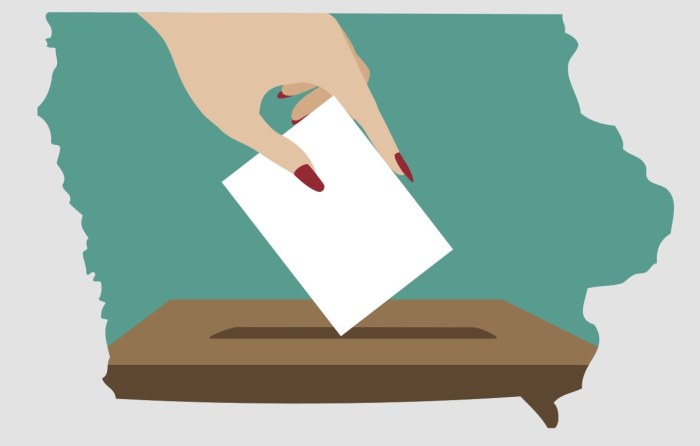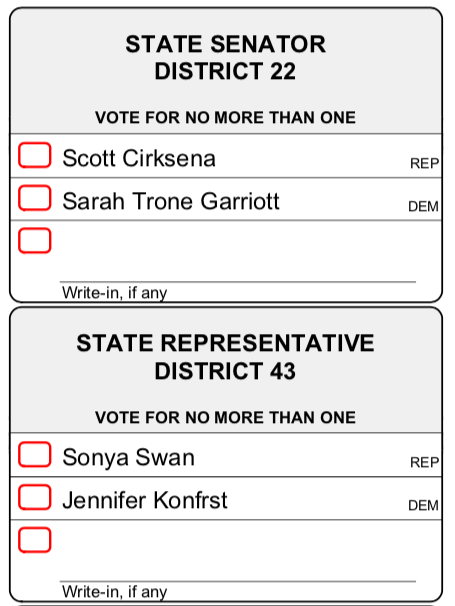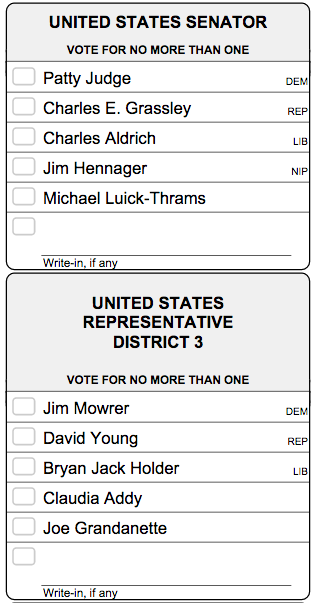If you’re among the hundreds of thousands of Iowans who received absentee ballots in the mail this week or voted early in person, you may have noticed that one party’s candidates were listed first on all of the races for federal and state offices. Perhaps the ballot order differed from your expectations; Republican candidates got top billing in several large, Democratic-leaning counties.
How did that happen?
WHAT CHANGED BEFORE THE 2020 ELECTION
For many years, Iowa law gave county auditors discretion to “determine the order of political parties and nonparty political organizations on the ballot.” Usually auditors listed candidates from their own political party first.
Political scientists have long observed that ballot position may tip a small fraction of votes to candidates listed first. Theoretically, the ballot order effect could change the outcome of a close election.
State lawmakers changed Iowa Code section 49.31 in 2019 to establish a set process for rotating the order of partisan candidates. The provision was part of a wide-ranging election bill, which changed shape several times as it bounced between the House and Senate. Bleeding Heartland covered the legislation here, but that post focused on more controversial proposals.
The relevant portion of House File 692 is enclosed below as Appendix 1. The language is convoluted, but the concept is simple. Iowa counties are assigned a number corresponding to their place in an alphabetized list (Appendix 2). In the 50 odd-numbered counties, Republican candidates will be listed first in presidential years and Democratic candidates listed first in midterm elections. In the 49 even-numbered counties, Democrats get the top line for each partisan office in presidential years, and Republicans do in midterm years.
Here’s a portion of the sample ballot for my Polk County precinct this year, showing state legislative races.
For comparison, here’s how Polk County ballots displayed the U.S. Senate and House races in 2016.
WILL IT MATTER?
Although the compromise bill passed the Iowa House and Senate unanimously, some might argue the system puts Democrats at a slight disadvantage in the 2020 election. Of the ten largest counties in terms of active registered voters, most of which reliably favor Democratic candidates, seven happen to have odd numbers. That means Republican candidates are listed first for every partisan race on every ballot in Polk, Linn, Black Hawk, Dubuque, Story, Dallas, and Woodbury counties. Democrats had the top line in most of those counties in 2016.
Of the ten most populous counties, only Scott, Johnson, and Pottawattamie have ballots listing Democratic candidates first.
The impact on the contest between Joe Biden and Donald Trump should be negligible. Summarizing research on the subject, Matthew Wills wrote in 2016,
Delbert A. Taebel showed that not only did candidates listed first enjoy a favorable advantage, but that this advantage was greater in contests further down the ballot. This advantage did not, however, hold when voters had high recognition of candidate names. This suggests that presidential elections, where there is generally much higher name recognition than in primary and off-year elections, are less likely to be influenced by name-order effects.
I would guess ballot order won’t affect many votes in Iowa’s U.S. Senate race either. Voters have been bombarded with so much advertising about Joni Ernst and Theresa Greenfield that their name ID must be very high by now.
In a very close race, the new ballot order rules could benefit two GOP Congressional challengers. Ashley Hinson’s name will appear above Abby Finkenauer’s on ballots in IA-01’s three largest counties (Linn, Black Hawk, and Dubuque). Similarly, David Young has top billing over Cindy Axne in the two IA-03 counties with the most registered voters (Polk and Dallas).
Conversely, Democrat Rita Hart has the ballot order advantage in Scott and Johnson counties, which are by far the largest two in the open second Congressional district.
Republicans hoping to keep their Iowa House majority can take heart from knowing their legislative candidates will be listed first in counties where many battleground races will be fought (Polk, Linn, Jackson, Jones, Jefferson, Fayette, Warren). On the other hand, several competitive state House races will happen in counties where Democrats are listed first (Scott, Pottawattamie, Marshall, Cedar, Muscatine, Wapello).
________________
Appendix 1: Relevant section of House File 692, which state lawmakers approved in 2019
DIVISION V
BALLOT ORDER
Sec. 48. Section 49.31, subsection 1, paragraph b, Code 2019, is amended to read as follows:
b. (1) The commissioner shall determine the order ofpolitical parties and nonparty political organizationscandidates on the ballot as provided in this paragraph. Thesequenceorder shall be the same for each office on the ballot and for each precinct in the county voting in the election.
(2) The state commissioner shall compile a list of each county in the state in alphabetical order and assign a number to each county such that the first county listed is number one, the second county listed is number two, and continuing in descending order in the same manner. The commissioner shall put in alphabetical order the top two political parties receiving the highest votes from the most recent election.
(3) The commissioner of each county assigned an even number pursuant to subparagraph (2) shall arrange the ballot as follows:
(a) The candidates of the first political party by alphabetical order pursuant to subparagraph (2) shall appear first on the ballot for the first general election at which the president of the United States is to be elected following the effective date of this Act and second on the ballot for the first general election at which the governor will be elected following the effective date of this Act and second on the ballot for the second general election at which the president of the United States is to be elected following the effective date of this Act and first on the ballot for the second general election at which the governor will be elected following the effective date of this Act, and thereafter alternating with the candidates of the second political party by alphabetical order pursuant to subparagraph (2).
(b) The candidates of the second political party by alphabetical order pursuant to subparagraph (2) shall appear second on the ballot for the first general election at which the president of the United States is to be elected following the effective date of this Act and first on the ballot for the first general election at which the governor will be elected following the effective date of this Act and first on the ballot for the second general election at which the president of the United States is to be elected following the effective date of this Act and second on the ballot for the second general election at which the governor will be elected following the effective date of this Act, and thereafter alternating with the candidates of the first political party by alphabetical order pursuant to subparagraph (2).
(4) The commissioner of each county assigned an odd number pursuant to subparagraph (2) shall arrange the ballot as follows:
(a) The candidates of the second political party by alphabetical order pursuant to subparagraph (2) shall appear first on the ballot for the first general election at which the president of the United States is to be elected following the effective date of this Act and second on the ballot for the first general election at which the governor will be elected following the effective date of this Act and second on the ballot for the second general election at which the president of the United States is to be elected following the effective date of this Act and first on the ballot for the second general election at which the governor will be elected following the effective date of this Act, and thereafter alternating with the candidates of the first political party by alphabetical order pursuant to subparagraph (2).
(b) The candidates of the first political party by alphabetical order pursuant to subparagraph (2) shall appear second on the ballot for the first general election at which the president of the United States is to be elected following the effective date of this Act and first on the ballot for the first general election at which the governor will be elected following the effective date of this Act and first on the ballot for the second general election at which the president of the United States is to be elected following the effective date of this Act and second on the ballot for the second general election at which the governor will be elected following the effective date of this Act, and thereafter alternating with the candidates of the second political party by alphabetical order pursuant to subparagraph (2).
(c) The commissioner shall determine the order of candidates of nonparty political organizations on the ballot. The order shall be the same for each office on the ballot and for each precinct in the county voting in the election.
Appendix 2: Iowa counties numbered by alphabetical order. Ballots in odd-numbered counties list Republican candidates first in presidential elections and Democratic candidates first in midterm elections. Ballots in even-numbered counties list Democratic candidates first in presidential elections and Republican candidates first in midterm elections.
1. Adair
2. Adams
3. Allamakee
4. Appanoose
5. Audubon
6. Benton
7. Black Hawk
8. Boone
9. Bremer
10. Buchanan
11. Buena Vista
12. Butler
13. Calhoun
14. Carroll
15. Cass
16. Cedar
17. Cerro Gordo
18. Cherokee
19. Chickasaw
20. Clarke
21. Clay
22. Clayton
23. Clinton
24. Crawford
25. Dallas
26. Davis
27. Decatur
28. Delaware
29. Des Moines
30. Dickinson
31. Dubuque
32. Emmet
33. Fayette
34. Floyd
35. Franklin
36. Fremont
37. Greene
38. Grundy
39. Guthrie
40. Hamilton
41. Hancock
42. Hardin
43. Harrison
44. Henry
45. Howard
46. Humboldt
47. Ida
48. Iowa
49. Jackson
50. Jasper
51. Jefferson
52. Johnson
53. Jones
54. Keokuk
55. Kossuth
56. Lee
57. Linn
58. Louisa
59. Lucas
60. Lyon
61. Madison
62. Mahaska
63. Marion
64. Marshall
65. Mills
66. Mitchell
67. Monona
68. Monroe
69. Montgomery
70. Muscatine
71. O’Brien
72. Osceola
73. Page
74. Palo Alto
75. Plymouth
76. Pocahontas
77. Polk
78. Pottawattamie
79. Poweshiek
80. Ringgold
81. Sac
82. Scott
83. Shelby
84. Sioux
85. Story
86. Tama
87. Taylor
88. Union
89. Van Buren
90. Wapello
91. Warren
92. Washington
93. Wayne
94. Webster
95. Winnebago
96. Winneshiek
97. Woodbury
98. Worth
99. Wright




2 Comments
Let’s make voting harder
Of course they also did away with a simple straight-ticket vote.
Iowasmitten Fri 9 Oct 1:04 PM
in fairness
this change doesn’t make voting harder. It gives GOP candidates a slight edge in some counties, Democrats in others.
Laura Belin Fri 9 Oct 2:00 PM